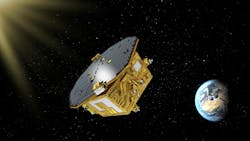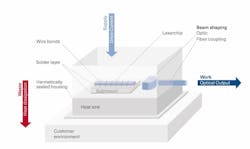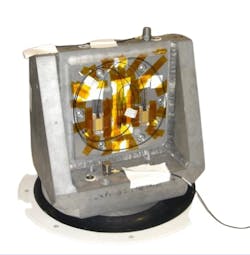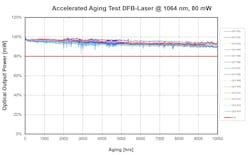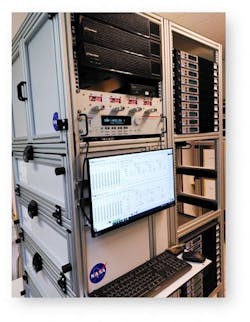Easier space qualification for laser diodes
Space exploration is at an inflection point—after decades of pioneering research missions, industry is stepping in and creating a market for space-based services. Thousands of new satellites have been launched, with more to come. As the number of launches increases, the technical challenge remains the same: every component for a satellite must withstand extreme vibration, temperature differences, and cosmic radiation.
As a result, each component must undergo a lengthy testing and qualification process. Much of this effort can be saved by incorporating existing parts and processes into the new system qualification. Laser diodes are essential for many satellite applications, including interferometry, spectroscopy, LiDAR, calibration, opto-pyro techniques, gas detection, and pumping other lasers. A relatively new application gaining traction is free-space laser communications.
Technology maturity/standards
To date, the level of technological maturity of most satellite components was classified according to technology readiness levels (TRLs). The U.S. National Aeronautics and Space Administration (NASA) developed the TRL definitions to address technical maturity, and each technology project is evaluated via an established technology readiness assessment (TRA) process and its maturity is determined based on a scale from 1 to 9.
Each level has its own milestone. At TRL 4, for example, a device is tested as a breadboard assembly. At TRL 6, a prototype is tested at relevant environment, which is a significant milestone in advancing the technology for space deployment. At TRL 9, the actual system has been flight proven through successful mission operations.
These tests must follow standards, such as NASA’s Technical Standard System (NTSS), as part of the NASA Technical Standard System Program (NTSP). It can be found on their website (https://standards.nasa.gov). Another standard widely used by NASA for environmental verification programs for Goddard Space Flight Center’s (GSFC) payloads, subsystems, and components is its General Environmental Verification Standard (GEVS) (https://standards.nasa.gov/standard/GSFC/GSFC-STD-7000).
The European Space Agency (ESA) has its own standards and also establishes test procedures. The European Space Components Coordination (ESCC) publishes the corresponding documents. The authors of this article worked with with ESA and European laser diode vendors to develop standards within the ESA Photonics Working Group and the ESCC. The ESCC has issued a number of documents, including the “Evaluation Test Program Guidelines for Laser Diode Modules,” a.k.a. ESCC Basic Specification No. 23201, and the “Validation and lot acceptance testing guidelines for laser diodes” (ESCC 23202; https://spacecomponents.org/specification/view?id=3647).
While it may look like a similar amount of paperwork, the real-world experience is a bit different. Regardless of the agency involved, the particular mission requirements need to be translated through the whole customer chain before it hits the laser diode vendor. This comes together with the more generic quality assurance requirements.
For most projects, component specifications have come a long way: some parts might be “heritage” or qualified for a previous mission, and others are determined by a change in separate components. For instance, each launch system has specific shock and vibration requirements for components. A Saturn V has different vibrations than a Soyuz rocket, and Ariane 6 or SpaceX's Starship has unique requirements—and all components and systems must be qualified for their specific launch vehicles.
Some specifications are mission-critical, while others are derived from other requirements. This leaves room for negotiation along the supply chain. During the development, test, and qualification process, the component supplier, the system integrator, and the payload or mission managers work together to identify components where a requirement can be modified to save time and money.
If a very rigid laser diode quality requirement leads to a selection process that rejects 90% of a batch, for example, the price of the component will increase accordingly. If this requirement can be relaxed, the price of the component can be decreased. Discussions of specifications can relate to device performance, test procedures, or materials, and often relates to the question of whether it’s already space qualified, because it can reduce the amount of testing required.
Challenges of laser diode qualification
The detailed steps of an application development including evaluation and qualification of optoelectronic components are beyond the scope of this article. The respective framework is given by the actual European ECSS-Q-ST-60 standard that defines standardized purchasing requirements for electrical, electronic, and electromechanical (EEE) space components.
Within this framework, ECSS standards define the conditions under which products, production processes, or manufacturers are awarded the ESA certificate for space qualification. Based on these requirements, the ESCC includes lists of qualified parts, qualified manufacturers, and the qualification procedure.
For a better illustration of procedures and related cost, we will now look at the example of a laser diode as shown schematically in Figure 1. The building blocks are closely related to the basic technological challenges for a space qualification:
- Laser chip (performance and reliability)
- Fiber coupling (efficiency and long-term stability)
- Fiber feed-through (stability and hermeticity)
- Optical path (collimation, isolation, polarization, fiber pigtail, optical connector, repeatability)
- Electrical connectivity (ampacity and solderability)
- Housing/packaging (robustness, hermeticity)
- Heat dissipation (interface matching).
For all these challenges, tests must prove the specifications can be achieved. It should be noted such tests might need to be repeated on a component and instrument level, and different TRLs may lead to additional tests and qualifications.
These tests can be grouped into certain related subgroups. According to ESCC 23202 Table F4B, eight groups of tests can be performed: mechanical, environmental, durability, assembly, electrostatic sensitivity, radiation, control, and thermal vacuum.
Figure 2 shows the setup for random vibration testing, in which the components were tested up to 65 gRMS in all three axes.
Figure 3 shows a laser diode aging test, in which 16 pieces were aged for 10,000 hours at a laser current of 80 mW at 50°C. The lifetime test typically costs between several 10,000€ ($10,864) to more than 100,000€ ($108,644). Vibration test costs are similar, but can vary depending on device and the test parameter complexity. A fully characterized chip on submount can cost 1000€ ($1,086) per piece, while a fully assembled laser diode module with fiber connector is closer to 5,000€ ($5,432). A complete set of tests for a laser diode according to ESCC 2320x can easily run from €750,000 to €1 million ($810,000 to $1.1 million).
Lasers/optoelectronics
As laser and optoelectronics technologies continue to expand and mature, more sophisticated instruments once believed too complicated for space are being considered and
developed.
Spaceborne LiDAR and laser-based scientific instruments are attracting interest from different agencies and research groups around the globe. Most, if not all, instruments are built upon the fundamental laser architecture that requires laser diodes as the source of excitation for certain gain medium to produce the final wavelength of choice by the mission.
The laser diode, either used as pumping source or seed source, has become the fundamental building block to make or break missions. TOPTICA EAGLEYARD is supporting the NASA LISA laser development by providing aging tests at their Berlin facilities (see Fig. 4). These tests provide the confidence the LISA program needs to meet mission lifetime requirements when it launches mid-2030s.
Benefits of heritage at the component level
Qualification and testing costs are problematic for projects and can be prohibitive for a small laser diode manufacturer. The way out of this trap is heritage, which means that when a component is tested and qualified it does not have to go through all of the tests again—if it’s manufactured the same way. For a heritage component, there must be original test documentation, and other documentation to prove the component is made the same way as the old one. Then the component can be integrated into a new device without (most of) the evaluation testing.
While this is well known at the instrument level, it is not as obvious at the component level. But it is possible, and engineers used it to save time and money when qualifying laser diodes for recent missions. The core idea is to identify blocks within the diode that are unique and can be considered legacy, regardless of specification differences. These can be physical parts, but also manufacturing processes. At TOPTICA EAGLEYARD, the amount of heritage is significant because the company has supplied laser diodes to many ESA and NASA missions.
Heritage at the component level is a way to make space qualification of laser diodes much faster and less expensive. It also makes sense from a laser diode vendor’s perspective. As a European-based player, we need to address innovative product solutions and simultaneously fulfill the highest quality standards. Technologically challenging space programs support both aspects of this strategy.
Using heritage to reduce certain costs enables or even accelerates progress. This approach will be essential to introduce more advanced components into existing and future fleets of thousands of satellites.
About the Author
Michael Kneier
Michael Kneier is VP of sales and marketing at TOPTICA EAGLEYARD (Berlin, Germany).
Claus Heitmann
Claus Heitmann is CEO of TOPTICA EAGLEYARD (Berlin, Germany).
Sascha Tornow
Sascha Tornow is head of quality at TOPTICA EAGLEYARD (Berlin, Germany).
